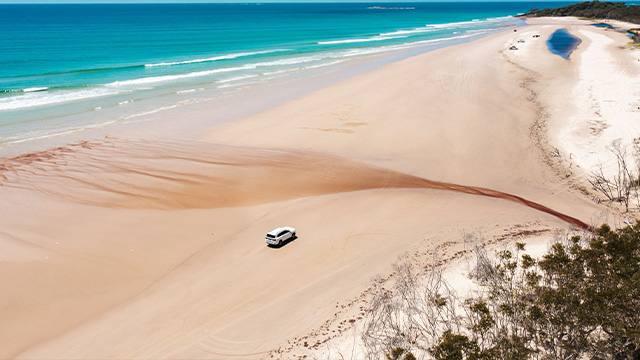Visiting Uluru – the centre of the universe

It’s rare that the view from a lookout truly blows you away, cobwebs and all.
With a flushed face and heaving lungs, I’ve reached Karingana lookout on a hike in the Valley of the Winds. True to its name, the air has gone from sheltered stillness below to an unrelenting roar at its crest. The vista stretching out beyond is otherworldly, with towering red cliffs framing a verdant gully that leads to more of Kata Tjuta’s domed rock formations in the distance.
I spread my arms out and lean into the cooling gale, feeling the rush of endorphins and awe in a tingle up the back of my neck. Natural highs don’t get much better than this.
How to get there
Flying directly here from Sydney is almost like cheating. Uluru-Kata Tjuta National Park seems so remote and wild it should require days spent off-road driving and camping to reach. One moment you’re in bustling Sydney and 3.5 hours later you land within virtual cooee distance of Uluru itself. The rock looms behind the airport terminal, only 18km away as the crow flies. It prompts a comically deadpan warning from a flight stewardess over the intercom that no photography is allowed on the tarmac: “The gorgeous view to the left is the exact same one you’ll get from the airport carpark.”
Where to stay
White Toyota Prado 4WDs are the rental car staple here and I pick up mine from said carpark for the short drive to Ayers Rock Resort. After Uluru became the foremost name for the iconic landmark ahead of Ayers Rock in 2002, it seems strange to still refer to the resort – and, indeed, Ayers Rock Airport – by its secondary name. I’m later told it hasn’t changed because Uluru is a proper noun from the Pitjantjatjara language and that consultation with the Anangu, Uluru’s traditional custodians, wasn’t in favour of applying it elsewhere.
The Ayers Rock Resort consists of different hotels and accommodation options, spanning campsites and shared dorms for those on a budget, to deluxe rooms, two-bedroom apartments and even $1100-a-night luxury suites.
What to do
I’m booked into the Desert Gardens Hotel over the next three nights and have time to settle into my comfortable digs until a 5pm bus transfer to the Wintjiri Wiru Sunset Dinner. Having launched in May last year, it brings ancient Anangu storytelling and culture to life in a sound and light show incorporating hundreds of drones.
Desert Awakenings tour
The evocative experience stays with me as I drift off to sleep back in my room and it’s still dark when I get up to join a Desert Awakenings tour of Uluru. The ungodly hour is more like peak hour at the pick-up area outside reception, which is positively buzzing with visitors keen to experience the sunrise from various parts of the park. Tour guide, Jack, wrangles our small group into a special 4WD light truck.
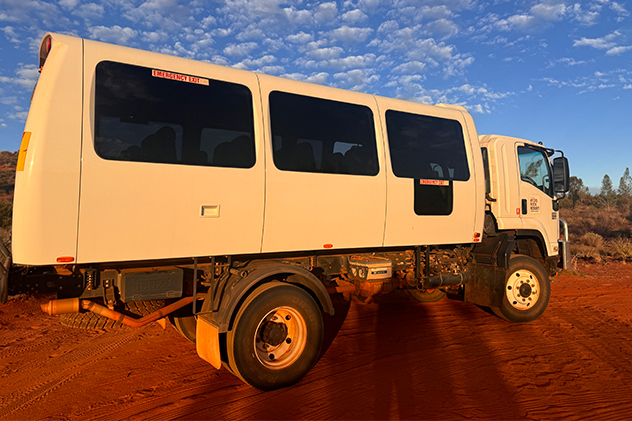
4WD light truck at dawn for the Desert Awakenings tour.
After a 20-minute drive we stop to scale a sand dune and Jack jokes that he’s going to make us work for our breakfast, but it’s only a short way up the dimly lit path to a platform with tables and chairs. Much-welcome coffee, bacon-and-egg rolls and pastries are served up, along with 360-degree views over the desert scrub as the sun nudges the horizon.
Uluru is ever-present in the distance and Jack talks about its geological history. “If you dug down to the base of Uluru, you’d go for about five kilometres. What we see is literally the tip of the iceberg,” he says.
Walking Uluru's Sacred Base
But up close is where Uluru’s magnificence can really be appreciated. We arrive to find visitors already exploring around Uluru’s base on foot, others on bicycles and Segways, but it’s far from crowded.
The weather isn’t quite cold enough to dwindle a thirsty fly population that finds the moisture on our faces irresistible, so some visitors wear nets over their heads for protection. If you want to avoid the flies, the winter months are the ideal time to visit Uluru and offer the most comfortable temperatures for exploring.
We head off on the Mala Walk at our own leisure, past a cave the Anangu’s ancestors used as a kitchen to prepare meals, culminating at the sheer walls of Kantju Gorge. There are small pools of precious kapi (water) at its base and the gorge’s shaded coolness makes it perfect for quiet contemplation.

On the Mala Walk
The Kuniya Walk then gives a real sense of Uluru’s connection to Tjukurpa (creation time) and information signs help us understand how features in the rock relate to it. We admire Aboriginal rock art at Mutitjulu cave and make our way through a grove of river red gums to the area’s most reliable waterhole that has sustained life for countless generations of Anangu.
Campground culture and sunset rituals
Back at the modern-day oasis of the resort, I meet campground manager, Melanie Webber, who tells me they’ll likely run at above 95 per cent occupancy of the resort’s campsites in the peak season until early October, so bookings are highly recommended. As we wander around the campground past the impressive motorhomes and off-road caravans, it’s clear she shares the adventurous spirit of these occupants and will soon be leaving on an epic caravan journey of her own to Tasmania.
Come late afternoon, I encounter more of these adventurous types at Uluru’s sunset viewing area, where many have set up picnic tables and chairs in front of their vehicles, or even in the trays of utes, to enjoy the changing orange-to-red hues over the rock’s western face.
Dinner tonight is a well-earned sirloin at Mangata bistro in the hotel. I return in the morning for its extensive breakfast buffet and consider myself suitably fuelled for a day of hiking in Kata Tjuta. There’s a hierarchy to the prehistoric-looking landscape on the 40-minute drive: red earth and shimmering gold spinifex on the bottom layer, mulga trees and shrubs in the middle, and wispy desert oaks rising highest.
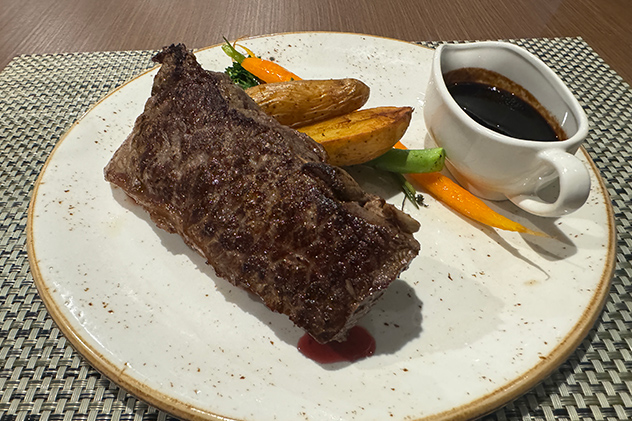
Sirloin steak with seasonal veg and jus at Mangata Bistro.
Valley of the Winds
The Valley of the Winds full circuit hike is 7.4km and rated grade 4 (the maximum rating is 5), meaning the path is often uneven and steep, and bushwalking experience is recommended. It’s easy going up to the first spectacular and windy lookout, which is where most visitors choose to stop and turn around, but the extra effort will pay off for those continuing to the previously mentioned Karingana lookout. Two other hikers are there wearing a look of elation similar to mine. We nod and smile at each other, knowing that speaking would only diminish the moment – and we’d likely have to shout to be heard above the wind. Once I descend to the gully, it returns to calm and the only sound is the chirping of birds flitting amongst the greenery.
The route then follows a dry creek bed and I meet an oncoming group of hikers. Fearing the way gets even more arduous ahead, I ask what made them turn back and one responds they didn’t know there was a ‘right’ way to do it. I realise they must have instead turned left to do the loop clockwise and are probably sick of being met with the same question from each person they encounter.
Walpa Gorge
After three hours hiking and two litres of drinking water, I’m back in the Prado with the air con blasting, exhausted but determined to see another must-visit part of Kata Tjuta. Walpa Gorge is a five-minute drive away and has a more sedate 2.6km return walk and grade 3 rating that’s suitable for most ages and fitness levels. Gazing up at colossal rock domes on either side of the gorge is almost vertigo inducing and they shade a tranquil splice of vegetation including wattle and native tobacco. Surprisingly, water is said to be abundant for the animals sheltering here and, even at this drier time of year, I have to step over a tiny creek to reach the end of the gorge.
The last evening of the trip has me booked into the Field of Light dinner experience. What began as a temporary art installation of 50,000 spindles of light by Bruce Munro in 2016 has now been extended indefinitely. Cheerful greetings of “palya’’ (hello) from staff at our sunset drinks set a celebratory tone and many of the guests have dressed up for the occasion.
It’s wonderful getting to know my tablemates – hailing from Lithuania, Germany, Japan and different corners of Australia – as we dine under the stars. Our previous guide, Jack, returns to give us some stargazing tips using a laser pointer, despite a full moon making it harder to discern the less-bright constellations.
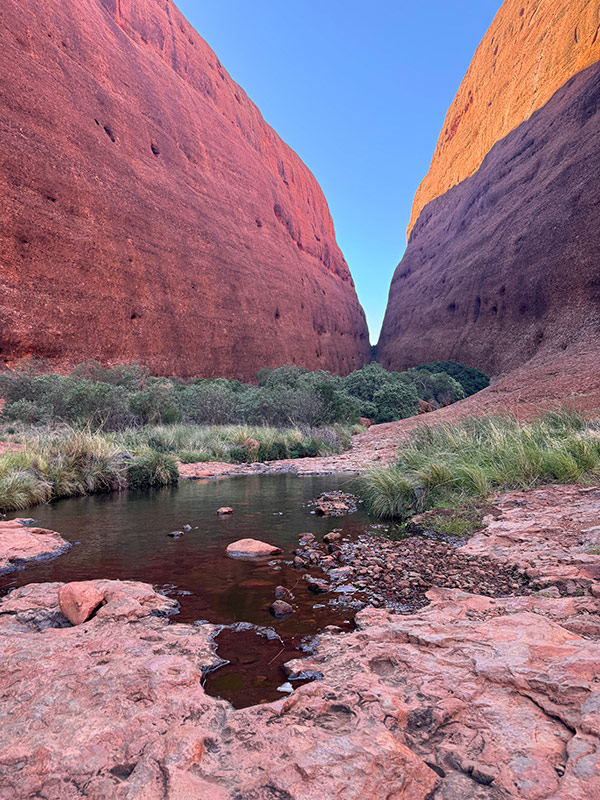
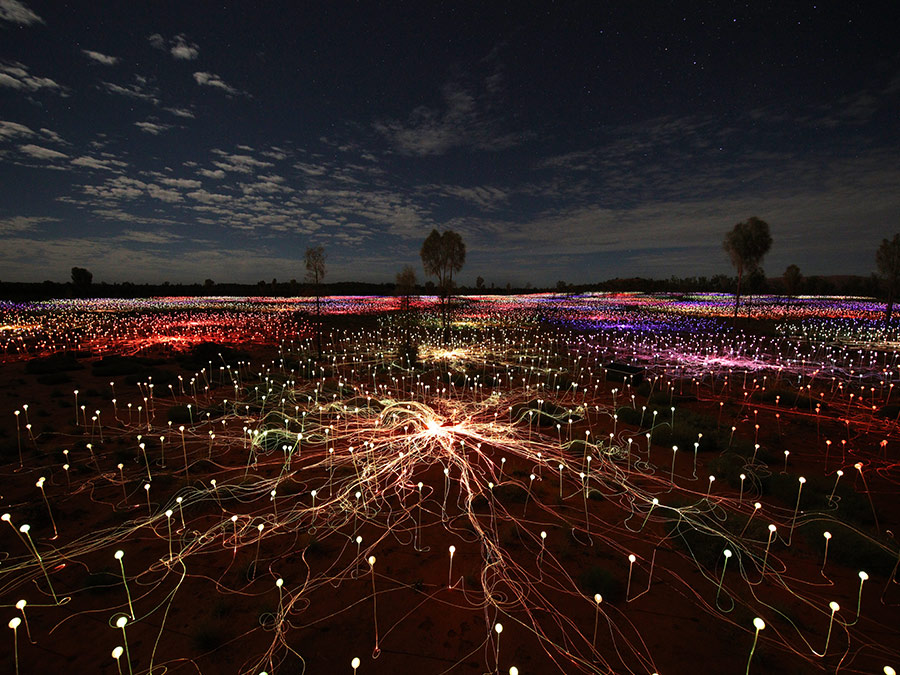
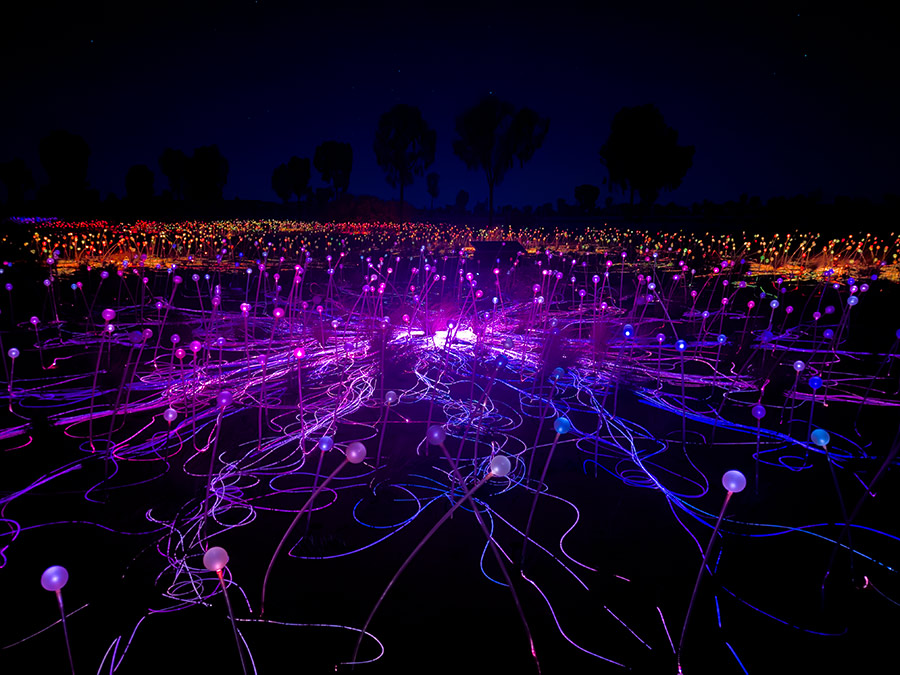
What’s impossible to miss are those magical lights sprouting from the nearby desert floor and slowly changing colours over an area spanning seven football fields. As we later wander amongst them, it’s like being on an awe-inspiring alien planet. It’s not quite the neck-tingling awe that Uluru and Kata Tjuta’s natural beauty evokes, but it’s as close as humanly possible.
For more information on accommodation and things to do in Uluru-Kata Tjuta National Park, visit ayersrockresort.com.au.
Experiencing Wintjiri Wiru
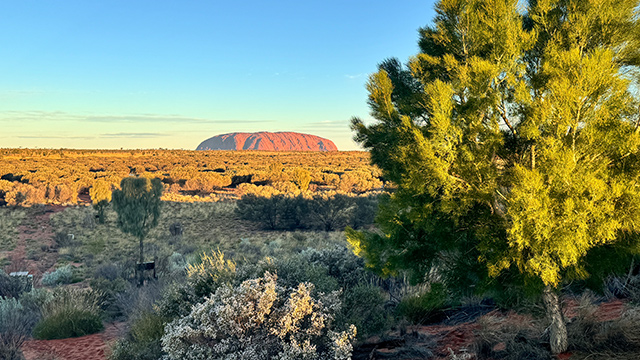
After our group is dropped off not far from the resort, a lone dingo crosses the dirt road behind the bus and quickly disappears back into the scrub. We meander up a short boardwalk to enjoy sunset drinks on a viewing platform, watching the colours and shadows change over Uluru in the fading light.
An assortment of bush-food-inspired canapes is served, including crocodile curry mini-pies and cauliflower mousse tartlets, with the surprising winner being a gin-infused cucumber sprinkled with green ants that taste like lime.
We then sit down on the outdoor theatre’s tiers and tuck into our gourmet hampers of cured meats, prawns, cheeses, olives, dips and salad. The dingo makes another brief appearance below, likely attracted to scents of smoked emu and blackened pepper leaf kangaroo, but it thinks better of coming any closer.
With darkness, the sky and scrub become a canvas as flying drones and light projections paint the ancient story of the Mala (a rufous hare-wallaby) people. Narration in English and the Pitjantjatjara language, as well as soul-stirring sounds of traditional dance ceremonies, accompany the spectacle.
We are all mesmerised for its duration and I can’t help wondering if the dingo is equally captivated, especially when the drones form the giant head of a devil-dog called Kurpany.
Acknowledgement: As custodians of the land, Anangu hold the Mala story from Kaltukatjara to Uluru. To share their story, RAMUS designed and produced an artistic platform using drones, light and sound to create an immersive storytelling experience.



